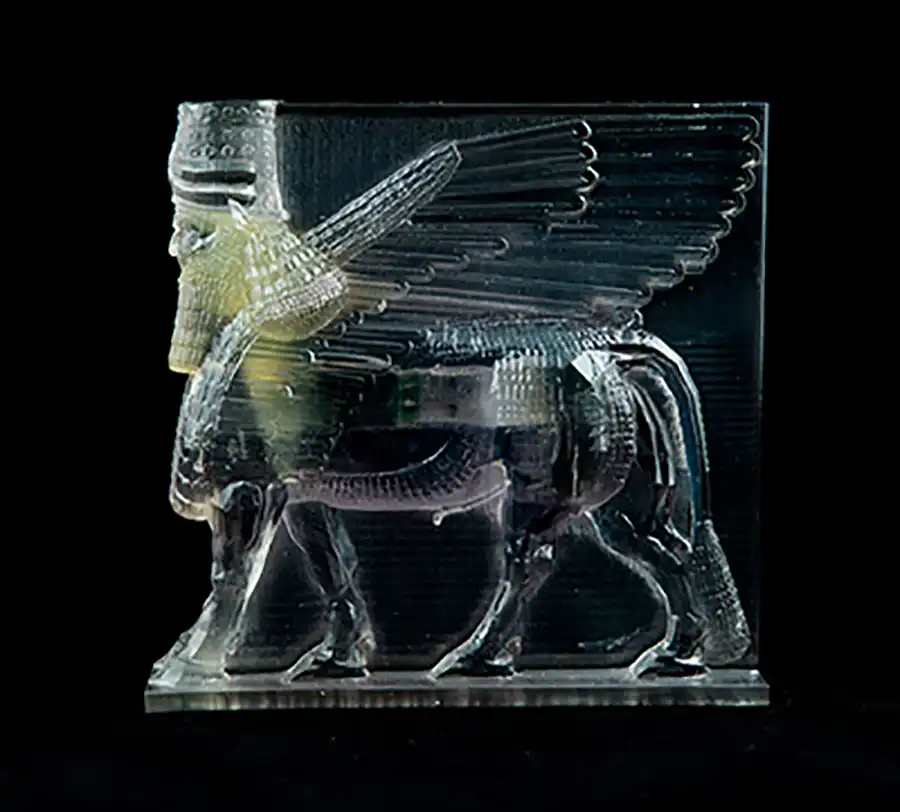Visiting Artist Discusses Cultural Artifacts

Last fall, the School of Art Programming Committee brought to campus Morehshin Allahyari, an artist, activist, educator, curator, and recipient of The Leading Global Thinkers of 2016 award by Foreign Policy magazine. Allahyari gave a public lecture as part of the School of Art Visiting Artist Lecture Series and opened an exhibition of her work at the UT Downtown Gallery in November. Her visit was co-sponsored by a grant from Ready for the World, the international and intercultural awareness initiative of UT.
Emily Bivens, UT professor of time-based art and a member of the programming committee, discussed the significance of Allahyari’s visit to Knoxville.
“We proposed Morehshin’s visit for a few reasons,” Bivens says. “First and foremost, she is an exciting artist making really compelling work. We also wanted to bring in an artist using new media in ways that our students might not have experienced. Since our new 3-D printing lab was in its second year, we also wanted the students to see how the medium could be used as a form of activism in addition to being a new tool they have access to now.”
While Allahyari’s work is wide-ranging, her 3-D-printed sculptural reconstructions of ancient artifacts destroyed by ISIS have received particular attention from curators and the press. Her lecture at UT attracted a larger-than-usual Knoxville community contingent, in part due to interest in her project Material Speculation: ISIS.
“Allahyari, however, was sure to clarify in her lecture that she wasn’t just saving artifacts, but also questioning ownership of cultural artifacts, and culture in general,” Bivens says. “She talked about cultural exchange and preservation as a complex situation with a legacy of colonialism.”
Allahyari’s lecture also addressed the conceptual foundation of Dark Matter, her 3-D-printed series of sculptural objects that are banned or unwelcome by the Iranian government, combined to form humorous juxtapositions.
Bivens expressed her hope that Allahyari’s visit broadened the perspective of UT students, exposed them to the complexity of the current political situation with Iran, and helped them to see methods of production and material as critical components of their work.
“I hope they see the important role of artist as activist and cultural commentator,” Bivens says.
Morehshin Allahyari was born and raised in Iran and moved to the United States in 2007. Her work deals with the political, social, and cultural contradictions we face every day. She thinks about technology as a philosophical toolset to reflect on objects and as a poetic means to document our personal and collective lives and struggles in the twenty-first century.
Allahyari has been part of numerous exhibitions, festivals, and workshops around the world, at venues including Venice Biennale di Archittectura, Pompidou Center, Museum of Contemporary Art in Montreal, Tate Modern, Queens Museum, Pori Museum, Powerhouse Museum, Dallas Museum of Art, Jeu de Paume, Contemporary Arts Museum of Houston, and Museum für Angewandte Kunst. She has been an artist in residence at BANFF Centre, Carnegie Mellon University’s STUDIO for Creative Inquiry, Autodesk Pier 9 Workshop in San Francisco, the Vilém Flusser Residency Program for Artistic Research in association with Transmediale, Berlin, and Eyebeam’s one-year Research Residency in New York City.
Her work has been featured in The New York Times, Huffington Post, Wired, Parkett Art Magazine, Frieze, Rhizome, Hyperallergic, and on National Public Radio and Al Jazeera, among others.
View the calendar of upcoming lectures in the School of Art.